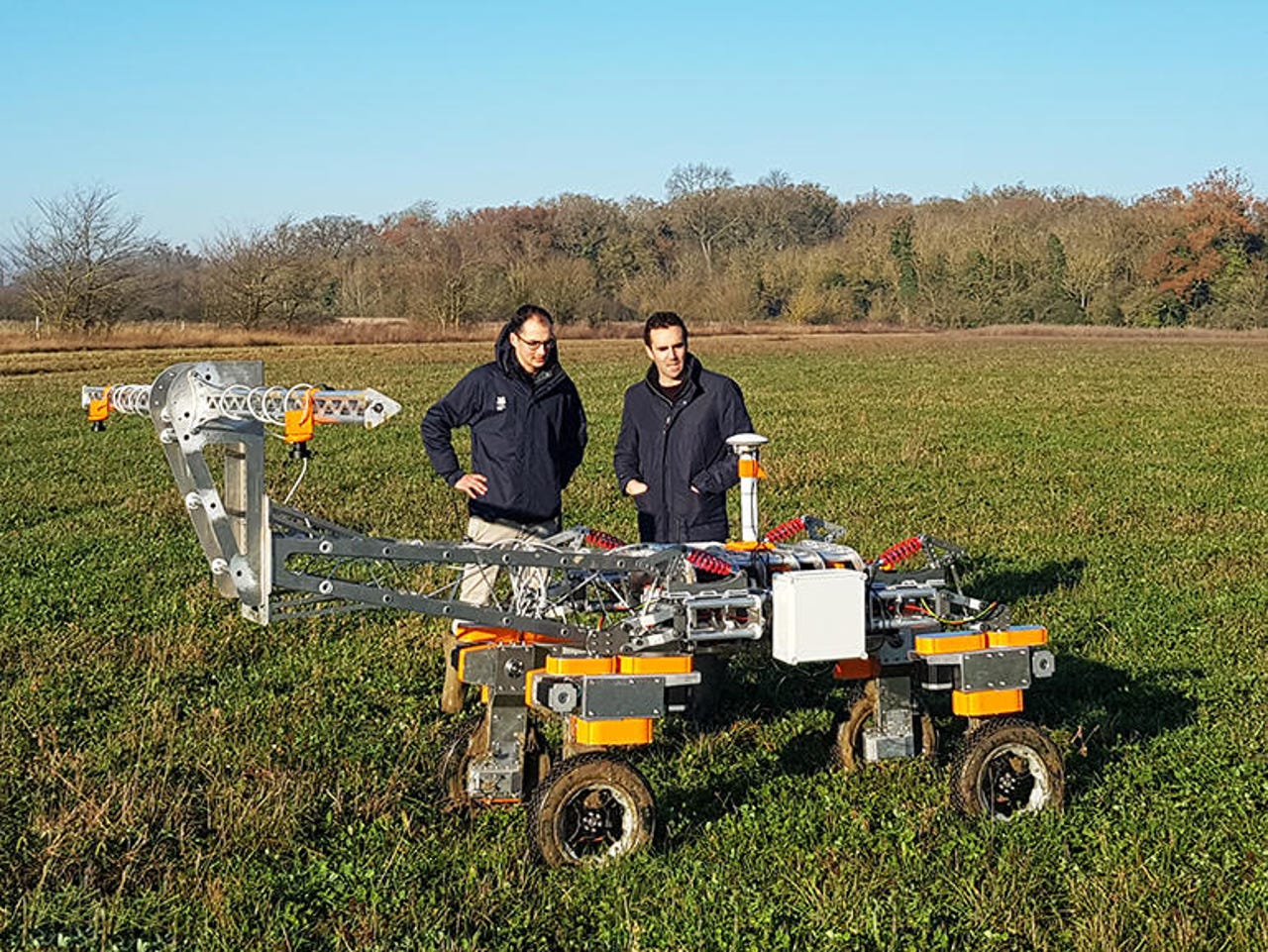Smart farming: This weed-hunting robot is taking to the fields

Sam Watson Jones (right), co-founder of Small Robot Company (SRC), with Callum Weir, farm manager at the National Trust's Wimpole Estate, and SRC's monitoring robot, Tom.
Robotics
Small Robot Company (SRC) is a pioneering UK-based agri-tech startup whose Farming-as-a-Service offering is based around a trio of lightweight robots — Tom, Dick and Harry — that respectively monitor, feed/weed and seed arable crops, directed by an AI system called Wilma. The idea is to create high-resolution crop maps, enabling precision husbandry with minimal environmental impact.
SEE: The future of food (ZDNet/TechRepublic special feature)
SRC has now launched its monitoring robot (Tom), which will deliver a trial commercial weed-mapping service. The company also announced that the non-chemical precision weeding component of the feeding/weeding robot (Dick) has reached Technology Readiness Level 4, pending early field trials in 2020.
SRC demonstrated Tom in action at the National Trust's Wimpole Estate in Cambridgeshire (one of 20 farms currently trialling the company's systems), with ZDNet in attendance. Also on show was the weed-zapping 'electricide' technology from another UK startup, RootWave, which will be adapted for installation in a prototype 'Dick' robot.
Monitoring robot (Tom)
The commercial 'Tom' design adds weather-proofing, speed, camera capacity and extended battery life to SRC's core set of robot technologies -- autonomy, geolocation, obstacle avoidance, navigation and accurate object positioning on a map. Tom weighs 150kg (and may slim down somewhat in future versions), compared to around 7 tonnes for a traditional tractor.
The Tom monitoring robot can cover 20 hectares a day, gathering 6TB of sensor data before requiring battery replacement and data download. The weed-mapping service will cost £15 per hectare, and it's expected that the monitoring robot will visit a given field four times during the growing season.
The heart of the Tom robot is an Nvidia Jetson System-on-Module (SoM) with CPU, GPU, power management, RAM and flash storage on a single board. Tom's cameras can see plant details at sub-millimetre resolution, with less than 1mm per pixel resolution on the ground, while power comes from four lithium iron phosphate batteries.
The Wilma AI -- developed by COSMONiO and running on Ubuntu -- can currently distinguish wheat from broad-leaved weeds, with identification of grass-type weeds such as blackgrass, brome and ryegrass -- a big problem for northern European farmers, but a tougher proposition for the AI because of their greater structural similarity to wheat -- to follow over the next growing season.
"Broadleaved weeds you can just do with visual data, but grass weeds require different cameras such as hyperspectral and stereo," SRC co-founder Sam Watson-Jones told ZDNet. "You increase the certainty of the AI by building up different layers of data."
The full commercial roll-out of the Tom robot's weed-mapping service is expected by 2021.
Non-chemical weeding technology
The RootWave Pro kills weeds with a blast of high-voltage electricity. This technology will be adapted for use in SRC's autonomous weeding robot, with field trials starting in 2020.
Organic farms such as the National Trust's Wimpole Estate try to minimise the use of herbicides, to the benefit of wildlife and the general environment. Non-chemical weeding is also a priority for SRC because chemical control of blackgrass is problematical, Watson-Jones said. That's why SRC has partnered with RootWave to adapt its 'electricide' technology for use on the precision-weeding 'Dick' robot.
RootWave's current product, RootWave Pro (see image), is a hand weeder designed for groundkeepers, growers and gardeners that kills unwanted plants by delivering a high-voltage (up to 5000V) blast, boiling the water in cells from leaf through stem to root. The challenge for the joint SRC/RootWave project, which is funded by a £1m grant from Innovate UK, is to slim down the system's size, weight and power consumption so that it can be mounted on an autonomous robot. By catching precision-mapped weeds at a young stage, it will be possible to use lower voltages than the current handheld device, with obvious safety and power-management advantages.
SEE: Ocado's robot warehouses are now heading to Japan
A commercial weed-zapping service using the Dick robot is expected to be available to SRC's trial farms from autumn 2021, the company said.
There's plenty more on SRC's roadmap, including Harry, the punch-planting member of the robot triumvirate, and the on-farm 'kennel' where monitoring robot Tom will retire to recharge its batteries and download data. The kennel is "two to three years away", Watson Jones said, with Harry "arguably even further down the line".
The immediate priority is commercial, said SRC's co-founder: "If we get the weed-killing done -- which is a big market -- and grow into that as quickly as possible, we can stop relying on equity investment and things like that, and actually start generating some serious revenues ourselves."
More on agri-tech
- Smart farming: How IoT, robotics, and AI are tackling one of the biggest problems of the century
- How self-driving tractors, AI, and precision agriculture will save us from the impending food crisis
- Agriculture 4.0: How digital farming is revolutionizing the future of food
- Transforming robot will mow fields, shovel snow
- Farmbot delivering remote watering solutions to Aussie farmers
